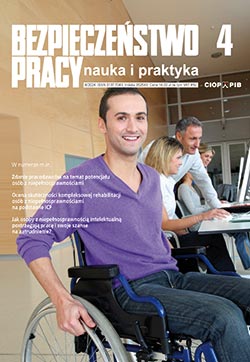Investigation of welders` exposure to particles present in welding fumes
Elżbieta Jankowska
This article presents the results of an investigation of concentrations and size distribution of particles emitted into the work environment during welding of acid-resistant steel with OK 61.30/308L-17 electrodes. Investigations carried out with gravimetric (PCIS samplers) and with optical (AERO-TRAK, GRIMM, DUST-TRAK) methods have shown that during the whole work day a welder can become exposed to various amounts of particles usually with a diameter under 10 µm; however, welding fumes contain considerable amounts of ultrafine and fine particles with a diameter under 1 µm.
The role of pro-health behaviors in promoting workers` health
Katarzyna Hildt-Ciupińska, Joanna Bugajska
Employment and work conditions are among the many determinants of human health. Different factors (physical, psychosocial) in the work environment contribute to the onset or intensification of many disorders. Coexistence of multiple factors (both in and outside the work environment) usually causes the onset of chronic diseases. Therefore, workers’ health care should not be limited to compliance with health and safety regulations; it should also include workers’ involvement in caring for their own health and well-being. Life style, which consists of the diet, physical activity, coping with stress, sleep and avoiding psychoactive substances, is the most important factor determining human health.
Evaluating proper selection of protective gloves for work involving hand knives - on the basis of questionnaire surveys
Emilia Irzmańska, Katarzyna Majchrzycka, Agnieszka Stefko
This article provides an evaluation of proper selection of protective gloves for work involving hand knives on the basis of questionnaires administered in 102 plants, e.g., meat production and processing plants, fish processing plants, plastic products processing plants, furniture and upholstery firms, and mushroom farms. The respondents were asked about the types of gloves used for work involving hand knives in relation to the risk of hand injuries, and the labelling of gloves according to the kinds of threat against which they provided protection. Given the study findings it may be concluded that in many cases inadequate protective gloves were used for hand protection. This publication is based on questionnaire surveys conducted by the Central Institute for Labour Protection – National Research Institute in conjunction with the National Labour Inspectorate within the operating areas of five Regional Labour Inspectorates in Bydgoszcz, Kielce, Kraków, Poznań, and Szczecin.
Effectiveness evaluation and choice of barrier fabrics used for protective clothing against ultraviolet radiation
Grzegorz Owczarek, Agnieszka Wolska, Grażyna Bartkowiak
The Ultraviolet Protective Factor (UPF) rating indicates how effective a fabric/textile is at blocking out solar ultraviolet radiation. A fabric with an UPF rating of at least 40 protects very well against harmful UV radiation .Unfortunately this rating couldn’t be implemented directly to fabric protective properties evaluation against artificial UV radiation. This is because the differences in spectral range and spectral distribution of natural radiation and artificial radiation emitted by different sources. Taking into account, that many workers are exposed to artificial UV radiation, they should be provided with protective clothing, which adequately block out this radiation. The article presents the way of choosing the new barrier factor of protective clothing against artificial UV on the base of elaborated new method and evaluation criteria of fabric protective properties against artificial UV.
Social media and their impact on OSH communication
Karolina Farin
The Internet has made it possible to create and develop new forms of communication, including social media, which very quickly began to be used for commercial purposes. This way of disseminating information has become popular and has improved not only in the business sphere, but also in the public sector, although here new solutions have been accepted with a greater dose of reserve and mistrust. Currently, social media are used in various thematic fields not only by individuals, but also by institutions which disseminate information from their field through that channel. This also applies to the field of occupational safety and health.
Working conditions in Poland against a background of other EU member states - European Working Conditions Survey results
Maria Antoniak
Since 1990 the European Foundation for the Improvement of Living and Working Conditions (EUROFUND) has been carrying out research on working conditions in the European Union. Thanks to a unified methodological approach the results the of survey, based on self-reported occupational exposure, are comparable among European Union countries. The European Working Conditions Survey is repeated every 5 years; its latest edition took place in 2010. The following article aims to present selected aspects of the Survey.




























